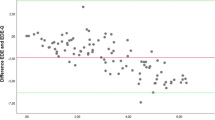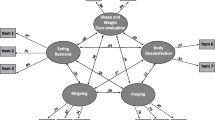Abstract
Background: Eating disorders (EDs) affect an increasing proportion of young women in western countries. Psychometric questionnaires represent valuable tools to investigate various and critical areas directly involved in the pathogenesis of EDS and to support diagnosis and therapeutic decisions. Methods: 162 young women (16–35 years old) seeking diettherapy were recruited. We classified subjects in normal eating behaviour (NEB) (n=87), binge eating disorder (BED) (n=12) and bulimic EDNOS (Eating Disorders not Otherwise Specified) (n=63). The SCOFF, Eating Attitudes Test (EAT 26) and Three Factor Eating Questionnaire (TFEQ) were administered. Body mass index (BMI) was utilised to assess the nutritional status. An analysis of the reliability and validity (sensitivity and specificity) of the SCOFF, EAT 26 and TFEQ was performed. Results: Body mass index (BMI) of NEB, BED and bulimic EDNOS was 27.7, 35 and 31.1, respectively. BED showed the highest values at the dishinibition, hunger and food preoccupation scales but, conversely, they were the least restrained group. The SCOFF was significantly associated with the dishinibition (r=0.31), hunger (0.31), dieting (r=0.34) and food preoccupation scales (r=0.34). The reliability analysis showed that the SCOFF, EAT 26 and TFEQ had a Cronbach alpha of 0.47, 0.85 and 0.75, respectively. The ROC curves identified cut off points of 3, 10 and 25 as the best compromise between specificity and sensitivity for the SCOFF, EAT 26 and TFEQ, respectively. Conclusions: The SCOFF is a valuable tool for the screening of abnormal eating behaviours but the diagnosis should be always confirmed and supported by the administration of other questionnaires and structured interviews. We have also confirmed the high reliability of the EAT 26 and TFEQ, even though the utilisation of these questionnaires has generated some issues about their application in populations characterised by loss of control and overeating episodes.
Similar content being viewed by others
References
Fairburn C.G., Harrison P.J.: Eating disorders. Lancet, 361, 407–416, 2003.
Austin B.S.: Prevention research in eating disorders: Theory and new directions. Psychol. Med., 30, 1249–1262, 2000.
American Psychiatric Association Work Group on Eating Disorders. Practice guideline for the treatment of patient with eating disorders (Revision). Am J Psychiatry (Suppl.) 157, 1–39, 2000.
American Dietetic Association, Nutrition Intervention in the Treatment of Anorexia Nervosa, Bulimia Nervosa and Eating Disorders non Otherwise Specified (EDNOS). J Am Dietet. Assoc., 101, 810–819, 2001.
Garner D.M., Olmsted M.P., Bohr Y., Garfinkel P.E.: The eating attitude test: psychometric features and clinical correlates. Psychol. Med., 12, 871–878, 1982.
Stunkard A.J., Messick S.: The three factor eating questionnaire to measure dietary restraint, disinhibition and hunger. J. Psychosom. Res., 29, 71–83, 1985.
Morgan J.F., Reid F., Lacey J.H:. The SCOFF questionnaire: assessment of a new screening tool for eating disorders. BMJ, 319, 1467–1468, 1999.
Luck A.J., Morgan F.J., Reid F., O’Brien A., Brunton J., Price C., Perry L., Lacey H.J.: The SCOFF questionnaire and clinical interview for eating disorders in general practice: comparative study. BMJ, 325, 755–756, 2002.
Cole T.J. Bellizzi M.C., Flegal K.M., Dietz W.H.: Establishing a standard definition for child overweight and obesity worldwide: international survey. BMJ, 320, 1–6, 2000.
Diagnostic and Statistical Manual of Mental Disorders (DSM-IV), Task Force on DSM-IV, American Psychiatric Association, 1994.
Perry L., Morgan J., Reid F., Brunton J., O’Brien A., Luck A., Lacey H.: Screening for symptoms of eating disorders: reliability of the SCOFF screening tool with written compared to oral delivery. Int. J. Eat. Disord., 32, 466–472, 2002.
Conti L.: Repertorio delle scale di valutazione in psichiatria. SEE, Florence, Italy, 2000.
Stunkard A.J., Wadden T.: 1990. Restrained eating and human obesity. Nutr. Rev., 48, 78–86.
Garfinkel P.: The eating attitude test. Twenty-five years later. Eat. Weight Disord., 6, 1–24, 2001.
Lowe M.R.: The effects of dieting on eating behaviour: a three-factor model. Psychol. Bull., 114, 100–121, 1993.
Lowe M.R., Whitlow J.W., Bellwoar V.: Eating regulation: the role of restraint, dieting and weight. Int. J. Eat. Disord., 10, 461–471, 1991.
Tuschl R.J.: From dietary restraint to binge eating: some theoretical considerations. Appetite, 14, 105–109, 1990.
Dingemans A.E., Bruna M.J., van Furth E.F.: Binge eating disorder: a review. Int. J. Obes., 26, 299–307, 2002.
Franko D., Omori M.: Subclinical eating disorders in adolescent women: a test of the continuity hypothesis and its psychological correlates. J. Adolesc., 22, 389–396, 1999.
Gleaves D.H., Lowe M.R., Snow A.C., Green B.A., Murphy-Eberenz K.P.: Continuity and discontinuity models of bulimia nervosa: a taxometric investigation. J Abnorm. Psychol., 109, 56–68, 2000.
Author information
Authors and Affiliations
Corresponding author
Rights and permissions
About this article
Cite this article
Siervo, M., Boschi, V., Papa, A. et al. Application of the SCOFF, Eating Attitude Test 26 (EAT 26) and Eating Inventory (TFEQ) questionnaires in young women seeking diet-therapy. Eat Weight Disord 10, 76–82 (2005). https://doi.org/10.1007/BF03327528
Received:
Published:
Issue Date:
DOI: https://doi.org/10.1007/BF03327528




